Speech Notes for a Talk to AIG Economy 2005
Good morning and thank you to AIG for the invitation to speak today.
At the Reserve Bank we do take very seriously the importance of talking to businesses and getting their perspective on economic conditions. It's something we've put a lot of effort into over the last few years, as we've built up our liaison group within the Bank, and developed our regional offices in the mainland state capitals. And we very much appreciate the cooperation we receive from groups like the Australian Industry Group in this process.
The Bank has had quite a lot to say about the economy over the last two or three weeks – first with our quarterly Statement on Monetary Policy, then with the Governor's parliamentary testimony, and then yesterday's policy announcement. It's not my intention to modify any of that material on the economy, other than to update it for newly released information. But what I'll be doing is to make some general observations about the economic situation, drawing on the various statements we've already made. In doing that, I'll start with a brief overview of the international scene, and then move onto the situation in Australia.
My first observation is that the international environment in which Australia finds itself at the moment is quite a favourable one (Graph 1). Growth of the world economy last year was 4.9 per cent, which is around the strongest figure for the last 30 years. Most expectations at this stage are that 2005 will be another strong year. For example, the latest Consensus forecasts, taken as at February, imply global growth this year of 4¼ per cent. If that forecast is realised, it would be the third successive year of above average growth, albeit a bit slower than last year's result.
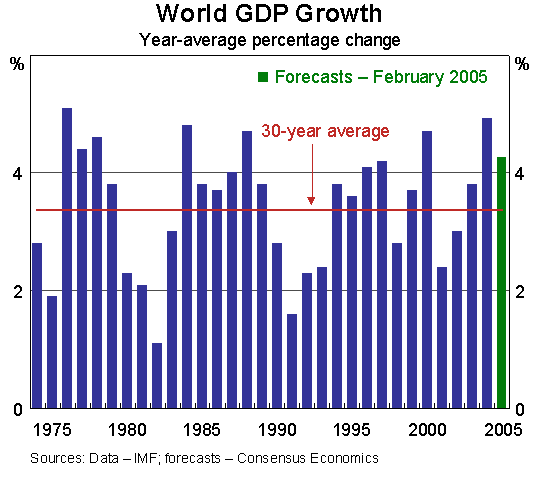
I won't have time to go into the global situation country by country, but it's worth taking a separate look at the US business cycle, which is still such a big influence on the world economy as a whole (Graph 2). The US is now in its fourth year of expansion after the recession at the start of the decade. The recovery initially got off to a fairly slow start. But the early concerns about lack of recovery in the business sector, and in employment, have now faded. Last year the US economy grew by just under 4 per cent, with the quarterly figures coming in at close to 1 per cent in each of the last four quarters.
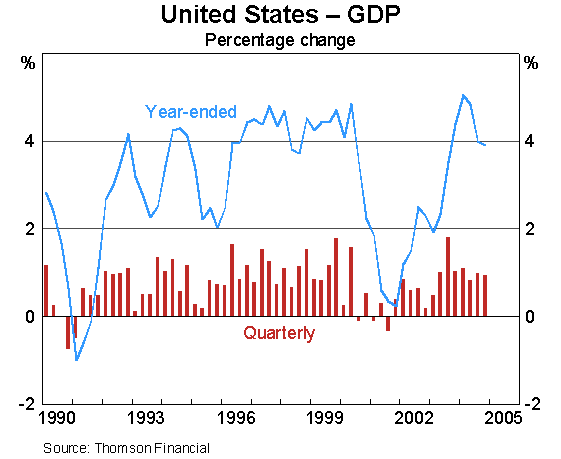
The latest indicators are generally pointing to further momentum coming into the early part of this year (Graph 3). Employment is growing at a fairly solid pace, and weekly figures on new jobless claims are back down to around their levels of the late 1990s. Other figures like retail sales and manufacturing production have also been looking quite strong in the early part of 2005. So overall, the US recovery is looking well entrenched.
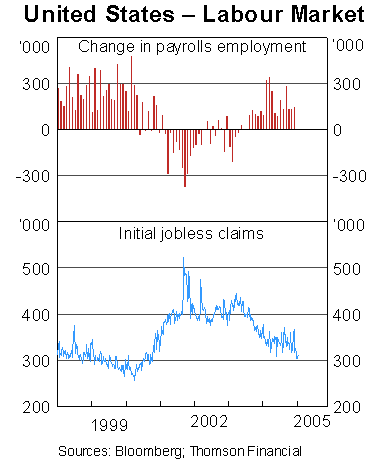
The other important driver of global growth at the moment is China (Graph 4). In the last couple of years the Chinese economy has been growing at rates not much below 10 per cent, and directly accounting for about a quarter of the overall growth in the world economy and in global trade. The main concern of the Chinese authorities last year was that the economy was overheating, and they have taken various measures since late 2003 to try to rein this in through credit controls and the like. These now seem to be having some effect, although any slowing to date seems quite mild.
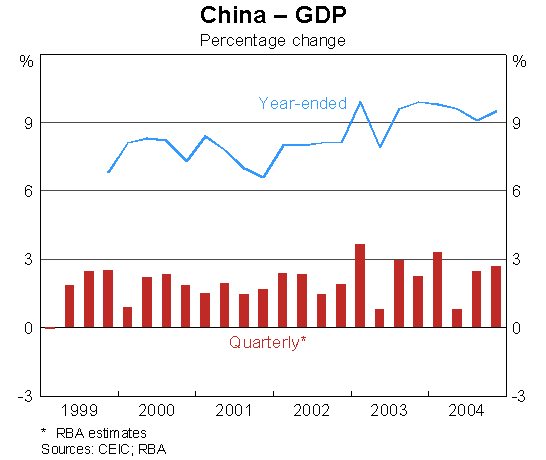
The recent performance and outlook in other parts of the world is more mixed (Table 1).
- Recent GDP outcomes for the euro area and Japan have been disappointing;
- But growth in most of the smaller east Asian economies remains quite strong, even if it has slowed a bit since last year.
| 2004 | 2005 Consensus Forecast | |
|---|---|---|
| United States | 4.4 | 3.5 |
| Euro Area | 2.0 | 1.7 |
| Japan | 2.6 | 1.1 |
| China | 9.5 | 8.4 |
| Other east Asia | 5.8 | 4.4 |
| World | 4.9 | 4.3 |
Obviously all these forecasts are going to be subject to revision as the year unfolds. But overall, as I indicated at the outset, growth of the global economy at this stage is looking quite strong. One important consequence of this has been upward pressure on commodity prices. Internationally, the most widely publicised aspect of that was the run-up in oil prices. These have strengthened again recently, although they're still below their peak of October last year. More directly relevant to Australia has been the sharp rise in a range of other resource prices. World prices of Australia's base metals exports are now up by more than 40 per cent over the past two years. For iron ore and coal, substantial increases in contract prices are set to take effect this year, after the sharp rises already negotiated in 2004.
A useful summary statistic for these effects is the movement in Australia's terms of trade (the ratio of export to import prices, Graph 5). Essentially this summarises the purchasing power generated by a given volume of exports. This ratio has already increased by 10 per cent over the past year. Some rough figuring suggests that the price increases for coal and iron ore over coming months will boost our overall index of commodity prices by over 20 per cent, and our terms of trade by a further 10 per cent (shown by the dot on the chart). This represents a significant stimulus to national income and spending. It will be the largest cumulative run-up in Australia's terms of trade since the early 1970s.
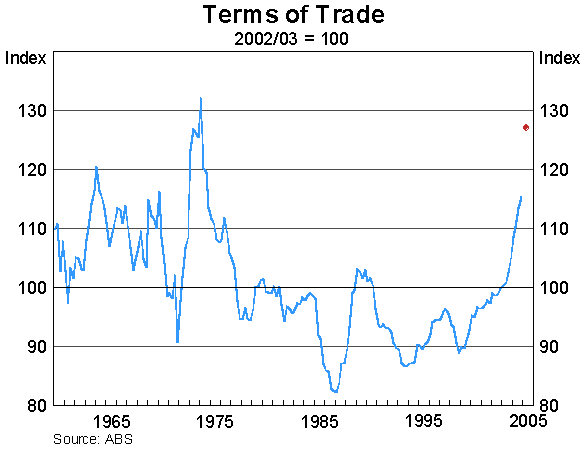
So the international background is one of above-average economic growth, and rising prices of the products that Australia exports.
I'll turn now to Australia. The national accounts released yesterday showed a continuation of the recent pattern of slower GDP growth and continued strength in domestic demand (Graph 6). GDP slowed to 1½ per cent over the year, and grew by only 0.1 per cent in the December quarter. Domestic demand, on the other hand, grew by 4 per cent over the year, and continued at that rate in the December quarter. It is thus growing a good deal faster than GDP. What the figures indicate is that the growth in demand is being met not by commensurate growth in production, but to a large extent by growth in imports and by a run down in inventories.
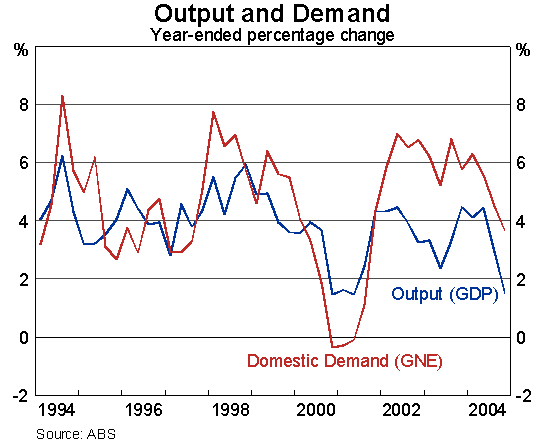
In its recent statements, the Bank has made two observations about this recent performance. The first observation concerns the balance of supply and demand in the economy. Taking the GDP figures at face value, what they indicate is that growth of output slowed down even though domestic demand over recent years has been running at a pace well above its longer-run trend. So during that period we have had a combination of strong domestic demand and better-than-average growth in the world economy, as well as a boost to national income from rising commodity prices. This combination of circumstances makes it hard to argue that the overall demand conditions facing the Australian economy have been deficient. Rather, what the Bank has argued is that it's becoming more likely growth is being constrained on the supply side. I'll come back to that point in a moment.
The second observation is that the slowing in growth seems at odds with general perceptions that the economy is growing strongly. Measures of business and consumer sentiment, for example, are at levels that would normally be associated with well-above-average growth. In the NAB survey of the non-farm business sector, businesses reported that conditions at the end of last year were close to their best since the survey began in 1989 (Graph 7). They did show a drop in January, but that seems to have been mainly seasonal. Other indicators, like the growth of business borrowing, profits and the rising share market, also bear out that the business sector in aggregate is enjoying strong conditions.
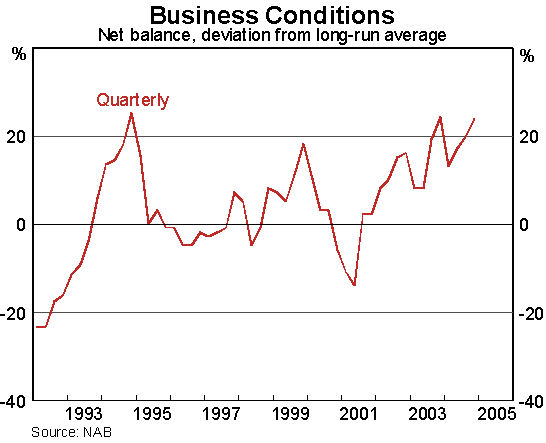
For the household sector, the Westpac-Melbourne Institute survey similarly reports sentiment at close to record levels (Graph 8). In fact this strengthened towards the end of last year and into the early part of 2005.
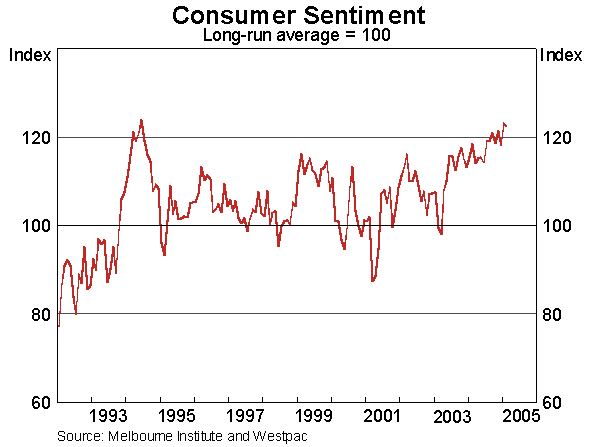
Another area of notably strong economic data has been the labour market (Graph 9). In the year to January, employment grew by 3.2 per cent, which is well above the trend growth in the labour force. Unemployment fell to 5.1 per cent, its lowest level since the 1970s. Other indicators such as job vacancies and hiring intentions are also pointing to strong labour demand.
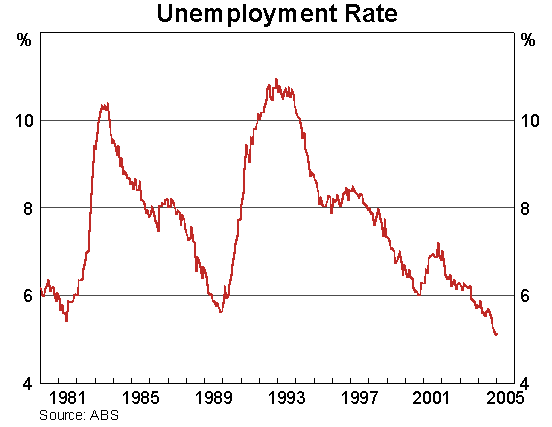
Obviously, it will never be the case that all economic data point in the same direction at a given time. One weaker indicator attracting comment recently was retail sales, though this seems to have overstated any weakness in overall consumption spending. Yesterday's national accounts showed consumption growth slowed down fairly modestly but was still running at a firm pace of just under 4 per cent over the latest year. Another general indicator of strong demand conditions is the rapid growth of imports, running at 13 per cent over the year (Graph 10). Overall, the sense we get from the general run of economic data is that confidence is high, and that demand conditions are providing plenty of encouragement to growth.
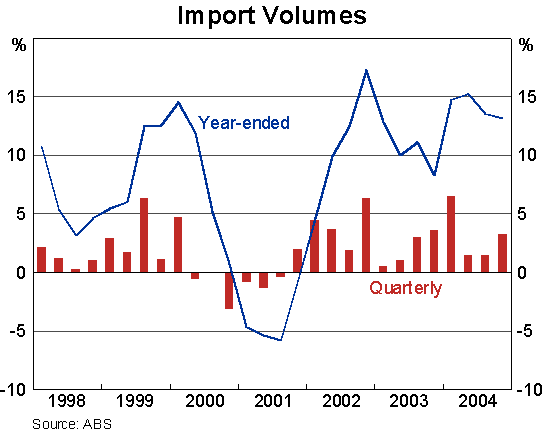
Returning to the question of pressures on the economy's supply capacity, the clearest indication that this has been occurring has been in the disappointing performance of exports over the past year or two (Graph 11). Despite the more favourable international situation, total exports as at the December quarter were not much changed from their level of four years ago. This is in contrast to the growth of the order of 7 per cent per annum that was sustained d uring the 1990s. It may well be that the 1990s was itself an unusual period in this respect, with export growth faster than normal. It was a period when we saw a big increase in the export orientation of the manufacturing and services sectors, and when Australia became much more engaged with the rapidly growing economies of east Asia. But even though that experience might be hard to repeat, the current flatness is remarkable, given that export volumes still tended to grow at healthy rates in most previous decades.
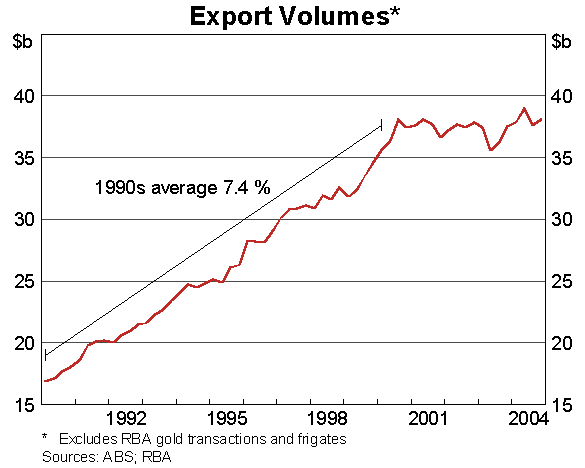
Looking across the components we can see that the flatness in exports over the last few years was widely spread (Graph 12). There were some temporary special factors that contributed to some of this, particularly around 2003. The drought pulled down rural exports around that time, and services exports were held back by the downturn in international travel, though both of these effects have faded more recently. Of the other components, it's noteworthy that manufacturing has been the strongest component of exports for many years. This has remained the case in the current decade to date, with manufactured exports continuing to grow, though not nearly as quickly as in the 1990s.
A lot of attention recently has been focused on resources exports, which is the largest component, accounting in recent years for a third or more of the total. Although they picked up in the December quarter, resource exports at the end of 2004 had still not shown much cumulative growth over the past four years, despite the recent strength in world demand and the growing appetite for resources from China. We devoted a special chapter to export performance in this area in our recent quarterly statement. Our assessment was that the reason for the lack of volume growth in resource exports to date is a combination of constraints, in extraction capacity and in transport infrastructure. The situation is quite a complex one, but the good news is that there are some significant capacity expansions now underway. So the prospects are that resource exports should start to do better, even though some of the capacity issues might still take a while to be resolved.
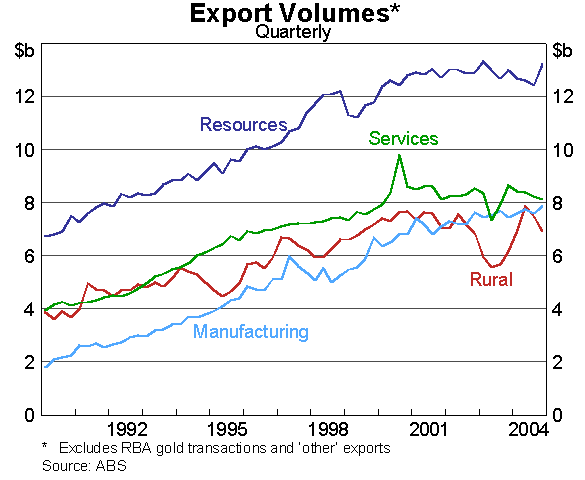
I commented at another event last week that the broader observation that supply constraints are becoming more important shouldn't strike people as all that surprising. The economy is now in its 14th year of expansion, and during that time substantial surplus capacity has been absorbed. The NAB survey, for example, reported that businesses' capacity utilisation at the end of last year was as high as at any time over the 15 years of the survey (although again, there was a fall in January which appears to have been mainly seasonal). It's also clear the economy has been using up surplus labour capacity, with unemployment down from a peak of almost 11 per cent to just over 5 per cent now. Reports of labour shortages are becoming widespread. The AIG, in fact, has been active in raising public debate about the issue of skills shortages, and emphasised that there is both a structural and cyclical element to the current shortage of skilled labour. The severity of the current skills shortage is captured by some of the business surveys which report the difficulty of finding suitable labour now is as high as it's been in the last two decades (Graph 13). The surveys also provide evidence that, for many businesses, shortages of labour have become a bigger constraint than traditional concerns about demand and sales.
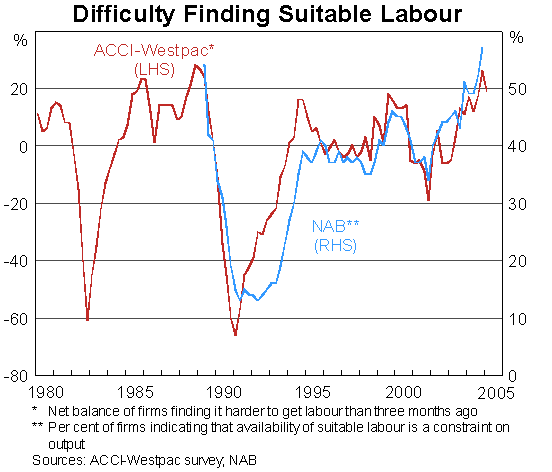
Against the background of capacity pressures in labour and product markets, and rising world commodity prices, it's not surprising to have seen broader price pressures emerging recently. Our quarterly statement noted that upstream price pressures had picked up during 2004. ABS data on producer prices showed that price increases at all stages of production were larger in the second half of the year than in the first half. These trends are consistent with business surveys, such as the one by the AIG, which have highlighted rising materials costs and also report a sharp increase in the proportion of firms raising selling prices, or expecting to do so (Graph 14).
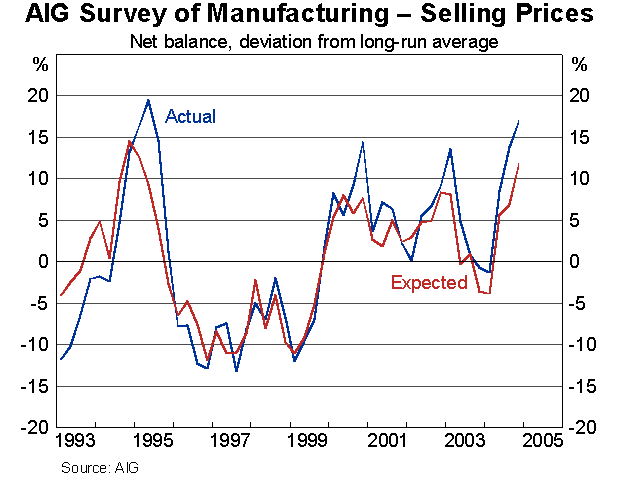
Consumer price inflation in 2004 was consistent with the target, at 2.6 per cent, with underlying measures running slightly below that figure (Graph 15). We've made the point for a while now that underlying inflation would be held down for a while by some temporary dampening effects from import prices, and that domestically sourced inflation was running more strongly. The producer price data that I referred to earlier have been showing broadly the same pattern. In the event, the inflation outcomes during 2004 were higher than we had expected, and this now looks to be the trough in underlying inflation. Given the evidence of capacity pressures and rising upstream prices, the forecasts that we've published recently are for a gradual increase in underlying inflation from here on.
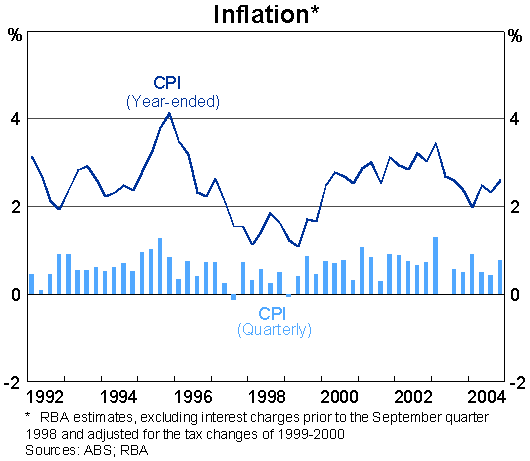
Before I sum up, I should reiterate that my comments today are not meant to add anything particularly new to the quite extensive commentary released by the Bank over the last two or three weeks.
To summarise the main points. The world economic situation to date has been a favourable one for Australia. Current expectations for the world economy are for a third year of above-average growth. In Australia, notwithstanding the lower-than expected GDP outcome, the evidence is that there has been no shortage of demand over recent years, and that businesses are becoming more concerned about constraints on supply capacity. A range of factors such as the favourable world environment, rising commodity prices, and high levels of confidence domestically, look like continuing to support spending growth in the period ahead.
Thank you very much.
Endnote
This is an expanded and updated version of a talk presented on 25 February 2005. [*]
